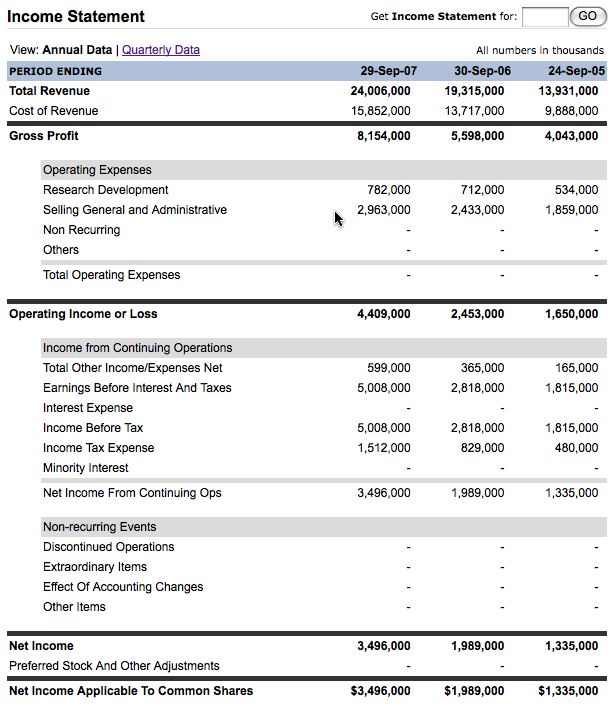Today I’ll be continuing the multi-part series Investing for Beginners. Don’t forget to read the first part, Stock Market Basics if you haven’t already. If you want to keep updated with new additions to the Investing for Beginners series then don’t forget to subscribe to the Debit versus Credit RSS feed. Today I’ll be covering a little bit about Accounting, specifically how to analyze financial statements.
Now hold on! Before you run away let me explain.
I realize that most of you are probably not especially fond of accounting, especially after having to endure the hell that is debits and credits. If you do enjoy accounting you are a member of a small minority and I congratulate you. As for the rest of us (myself included) accounting is much too tedious and sometimes even a little bit confusing. That’s not what we’re here for today, though. Today I will be teaching accounting, this much is true. I will only be teaching what is necessary for the dissection of financial statements, which can then be applied to researching a company that you might be interested in investing in. I promise it will be easy but more importantly it will be useful and FUN!
The only accounting that you should ever have to do when it comes to researching investments is as simple as reading existing financial statements. I am going to provide examples of an income statement today and on the next update I’ll cover the balance sheet and cash flow statements. I’ll point out what’s important and how you can use these statements to analyze how well a company is doing financially.
The Income Statement
With the Income Statement we want to pay attention to several numbers, with Gross Profit and Net Income being the most important. This is an annual report which lists the Net Income for the years ended Sep 24 of 2005, Sep 30 of 2006 and Sep 29 of 2007. This means that the income and other figures listed are from the fiscal year beginning in October and ending in September of the following year.
The difference between revenue from sales and the cost of providing the product or service for said sales.
What do the numbers mean? And what do we do with them? There are some relatively obvious ways to dissect this Income Statement. For example Apple’s net income for the year ended September 2007 was $3,496,000,000 ($3.5 billion) dollars. If you compare this to the previous year ($1.9 billion dollars) then it seems that Apple is doing something right. But we’re doing something wrong. Comparing dollars to dollars isn’t usually the best way to read financial statements, as it’s akin to comparing apples and oranges – especially when trying to compare Apple’s net income against say Dell’s or Microsoft’s. So how do we do it?
Use percentages!
Let’s look first at Apple’s Gross Profit for the year ended Sep ’05.
It’s $4,043,000,000 (the numbers are in thousands).
Now look at their gross profit the following year.
It’s $5,598,000,000.
Now divide the most recent year (that you’re looking at) by the previous year (2006/2005) and you get a number (1.38) which if put into percent format shows you that Apple made 138% of the profit that they made in 2005 in the year 2006. In other words they made 38% more in 2006 than they did in 2005.
What’s this number like for 2007? Just divide 2007/2006 and you come up with a 45% increase over year 2006. This is a good thing! Their gross profit percentage is trending upwards, meaning that it is increasing year after year.
The “bottom line.” It refers to the amount of money that a firm has left over after paying all of the bills.
Now let’s check out their net income. For the year 2006 they posted an increase in their net income (over 2005) of 49% and for the year 2007 an increase over 2006 of 75%. These numbers are amazing! It was good that their gross profit was trending upwards with some high percentages, but the net income percentages are even larger! Essentially this means that their income is increasing at a higher percentage than their expenses are. Check out their “selling and general administrative” costs if you don’t believe me. 30% and 21% – that’s how much selling and general administrative costs increased.
Based on what we’ve seen with Apple’s income statement they’re in a great position, in terms of growth. Their Gross Profit and their Net Income has been increasing at a steady rate over the past several years. If they can continue with this level of growth then it’s almost a given that the AAPL share price will continue to increase over the months and years. After all as long as a company is growing, then shouldn’t their share price continue to grow also? Technically yes, but there’s a lot more that goes into share price than just profit. Stay tuned for more Investing for Beginners!
That’s going to be it for today. Don’t forget to subscribe to the Debit versus Credit feed so you can make sure to receive updates to the Investing for Beginners series as they are posted!



4 responses to “Investing For Beginners: Analyzing Financial Statements”
When I saw the title “Fighting Financial Ignorance” I though about how I could forwrad this to our elected officials in Washington!
Great post!
Nice one, it is for beginners, but also an ‘expert’ can learn from this. I bookmarked it and will be taking a closer look at it a little later. LOL. After investing some more money!
Marc Williamss last blog post..Unfair and Deceptive Collection Tactics
[…] you enjoyed this article you can read more of Joseph’s advice on investing for beginners at his blog, Debit versus […]
[…] you enjoyed this article you can read more of Joseph’s advice on investing for beginners at his blog, Debit versus […]